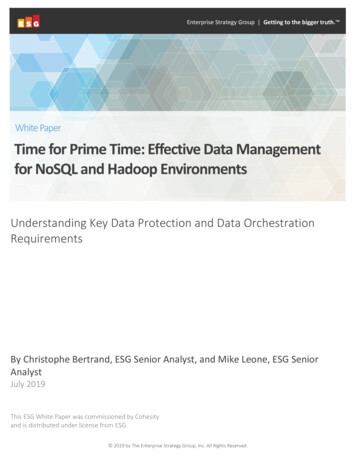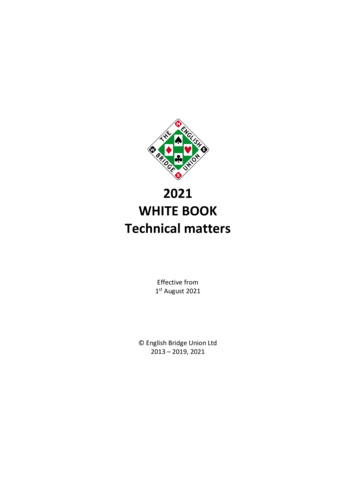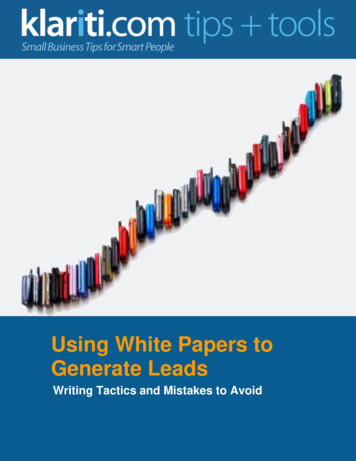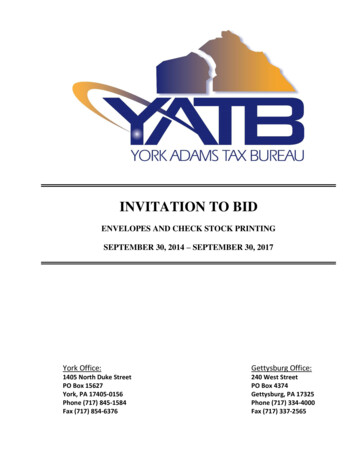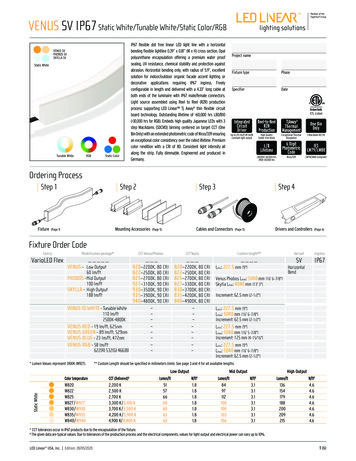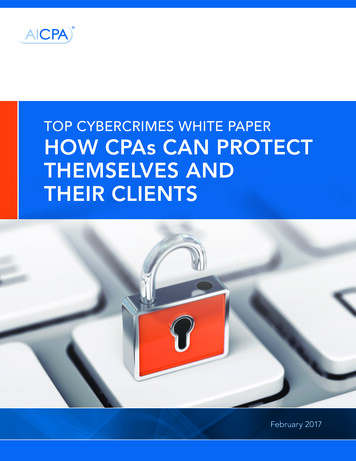
Transcription
TOP CYBERCRIMES WHITE PAPERHOW CPAs CAN PROTECTTHEMSELVES ANDTHEIR CLIENTSFebruary 2017
AUTHORS:Jeff Streif, CPAKoller Enterprises Inc.Fenton, MOLisa Traina, CPA/CITP, CGMATraina & Associates, a CapinCrouse CompanyBaton Rouge, LASteven J. Ursillo Jr., CPA/CITP, CGMASparrow, Johnson & Ursillo Inc.West Warwick, RIREVIEWERS:Susan Pierce, CPA/CITP, CGMAAssociate DirectorInformation Management and Technology Assurance DivisionAICPA, Durham, NCIesha Mack, PMPManagerInformation Management and Technology Assurance DivisionAICPA, Durham, NC 2017 Association of International Certified Professional Accountants. All rights reserved.DISCLAIMER: The contents of this publication do not necessarily reflect the position or opinion of the American Institute of CPAs, its divisions andits committees. This publication is designed to provide accurate and authoritative information on the subject covered. It is distributed with theunderstanding that the authors are not engaged in rendering legal, accounting or other professional services. If legal advice or other expert assistanceis required, the services of a competent professional should be sought.For more information about the procedure for requesting permission to make copies of any part of this work, please email copyright@aicpa.org with yourrequest. Otherwise, requests should be written and mailed to the Permissions Department, AICPA, 220 Leigh Farm Road, Durham, NC 27707–8110.
TABLE OF CONTENTSExecutive Summary. . . . . . . . . . 2What Is a Cybercrime?. . . . . . . . . 3Top Cybercrimes. . . . . . . . 41. Corporate Account Takeover. . . . . . . . . . 42. Identify Theft. . . . . . . . . 63. Data Theft . . . . . . . . 74. Ransomware. . . . . . . . . 8What You Can Do. . . . . . . . . 91. C onduct a Security Audit and Assess Controls. . . . . . . . 92. Retain Business Insurance. . . . . . . . 103. Create an Incident Response Plan. . . . . . . . . . 10Conclusion. . . . . . . . 11
EXECUTIVE SUMMARYWe remember the good old days when the hottest topic linked to cybercrime wasidentity theft. Today, there’s much more to cybercrime than a hacker stealing a SocialSecurity number. In fact, ID theft is only one of the top cybercrimes making its waythrough today’s business marketplace. Others include corporate account takeover, theftof data and ransomware. AICPA Information Management and Technology AssuranceCybersecurity Task Force members Jeffrey Streif, CPA, CFO at Koller Enterprises; LisaTraina, CPA/CITP, partner of Traina & Associates, a CapinCrouse Company; and SteveUrsillo Jr., CPA/CITP, partner at Sparrow, Johnson & Ursillo Inc., compiled a list of today’stop cybercrimes to help CPAs leverage their role as trusted advisers to better protectorganizations from data breaches and business interruptions.This white paper defines cybercrimes, examines the aforementioned crimes and theireffect on data and systems, and explains how CPAs must steward organizations insecuring data, keeping information both reliable and available.2 TOP CYBERCRIMES WHITE PAPER: HOW CPAs CAN PROTECT THEMSELVES AND THEIR CLIENTS
WHAT IS A CYBERCRIME?A cybercrime is, “anintended illegal actinvolving the useof computers orother technologies.”There are many definitions of cybercrime. Based on informationprovided by the FBI and our own experience as CPAs, a cybercrimeis “an intended illegal act involving the use of computers orother technologies.” Some examples include spreading computerviruses, stalking, phishing, perpetrating insider threats and causinga denial-of-service (DoS) attack (when an attacker atttempts toprevent legitimate users from accessing information or services).The criminal activity must take place in a virtual setting over theinternet, on a local network or in the cloud.According to C-SAFE, the Florida Cyber-Security Manual, cybercrimesshare three elements:1. Tools and techniques to perpetrate a crime2. Approach or methodology for executing the criminal plan(known as a vector)3. T he crime itself that is the end result of those plans and activities;a cybercrime is the ultimate objective of the criminal’s activitiesTOP CYBERCRIMES WHITE PAPER: HOW CPAs CAN PROTECT THEMSELVES AND THEIR CLIENTS 3
TOP CYBERCRIMESIn 2012, global corporateaccount takeover losses wereabout 455 million, andjumped to 523 million in 2013.CORPORATE ACCOUNT TAKEOVERA corporate account takeover ranks among the fastest and stealthiesttypes of attack. It’s costly and affects entities of all types and sizes.Cybercriminals engaging in this activity obtain an entity’s financialbanking credentials through social engineering and use malware tohijack the entity’s computers for the purpose of stealing funds fromthat entity’s bank account.In 2012, global corporate account takeover losses were about 455 million and jumped to 523 million in 2013 according to JulieConroy, fraud expert analyst and research director at the Aite Group.The growth rate continues to be robust and — in information providedby BankInfoSecurity and CUInfoSecurity’s Tracy Kitten — is projected toreach nearly 800 million by the end of 2016.THE CRIME’S COURSEAlthough corporate account takeovers can vary, we are discussingprimarily electronic-funds-transfer fraud, such as Automated ClearingHouse (ACH) or wire transfer. To perpetuate these types of schemes,criminals take three steps:1. Illicitly acquire login credentials. The credential compromise usuallyis accomplished by using a malicious program distributed as an emailattachment, unintended web browsing download or file transfer of aseemingly legitimate/safe file. The user inadvertently downloads andinstalls a malicious program, such as a Trojan, and usually is unawarethat anything threatening is occurring.2. Covertly gain unauthorized access to the victim’s computer to avoidthe bank’s security features, activated when it does not recognizethe login “fingerprint.” When customers open accounts at financialinstitutions, login “fingerprints” are created as an extra securitymeasure. With every subsequent login, the fingerprint verifies thelegitimacy of the person who’s accessing the account. If the fingerprintdoesn’t match, the process triggers an additional layer to the login,such as a security question or a temporary PIN. In this step, thecybercriminal uses a hacker tool to hijack the victim’s computer system,using the system as a trusted source to avoid the security check of thebank’s login fingerprint. This approach allows the criminal to conductfraudulent wire transfers out of the victim entity’s bank account.4 TOP CYBERCRIMES WHITE PAPER: HOW CPAs CAN PROTECT THEMSELVES AND THEIR CLIENTS
3. Transfer the victim’s bank funds to an account thecybercriminal controls. The cybercriminal typicallywires most, if not all, of the funds out of the victim’sfunds, usually by wire transfers. The cybercriminaltypically transfers the funds to individuals knownas money mules who in turn move the funds to anunregulated account, such as an overseas bankaccount in a country that is uncooperative withU.S. banking rules and protocols.THE CHALLENGE FOR CPAsCybercriminals typically target small- and medium-sizedbusinesses (SMBs) because these organizations tend topay less attention to information security, controls andrisk assessments and are therefore more vulnerable thanlarger entities. In many cases, SMBs don’t have enoughstaff in the finance function and not all staff have thelevel of expertise to spot these issues, which can lead tofurther risks.Chief accounting officers (CAOs), chief financial officers(CFOs), treasurers and controllers are particularly at riskbecause they are both easily identifiable online and aremost likely to conduct online banking transactions fortheir entities. The savvy cybercriminal also knows thesteps to take to access accounts, as well as the securityfeatures associated with online banking.There are at least two risk areas forCPAs who perform online bankingtransactions. First, the CAO, CFO,treasurer or controller often isunaware of corporate accounttakeovers, and the repercussions andliability that can follow. Second, thereis a lack of adequate controls overthe online banking process.cybercriminal’s persistent attack can overcome evenfairly stringent controls, and these controls can createa false sense of security when, in reality, there still issubstantial risk.CPAs can help educate their SMB clients about this typeof cybercrime. CPAs in management accounting or otherkey positions of responsibility at an SMB should becomeknowledgeable and vigilant of the full-range of controlsand vulnerabilities related to online banking.There are at least two risk areas for CPAs who performonline banking transactions. First, the CAO, CFO,treasurer or controller often is unaware of corporateaccount takeovers and the repercussions and liabilitythat can follow. Second, there is a lack of adequatecontrols over the online banking process. However, aTOP CYBERCRIMES WHITE PAPER: HOW CPAs CAN PROTECT THEMSELVES AND THEIR CLIENTS 5
IDENTIFY THEFTIdentity theft typically occurs when a cybercriminalsuccessfully steals personally identifiable information(PII). According to NIST’s Guide to Protecting theConfidentiality of Personally Identifiable Information,PII is any information about an individual an agencymaintains, including (1) any information that can be usedto distinguish or trace an individual‘s identity, such asname, Social Security number, and date and place of birth,mother‘s maiden name or biometric records; and (2) anyother information that is linked or linkable to an individual,such as medical, educational, financial and employmentinformation. This type of cybercriminal does not reallybenefit unless there is a financial reward for the effort orsome type of damage that can be done with the data.Consequently, identity theft serves as a gateway to othercybercrimes, such as tax-refund fraud, credit-card fraud,loan fraud and other similar crimes.Some examples of the malicious purpose behind identitytheft include: O pening a line of credit Purchasing goods or services Renting or buying a house or apartment Receiving medical care O btaining employment O btaining prescriptions Committing traffic infractions or felonies Auction and wage-related fraud E xtortionTHE CRIME’S COURSEAccording to the Identity Theft Resource Center (ITRC),identity theft complaints ranked first in 2014 in theFederal Trade Commission’s (FTC) list of complaints.In fact, identity theft was the FTC’s No. 1 complaint6 Identity theft can go undetected for asignificant period of time — 50% ofidentity thefts go undetected for atleast one month, and 10% remainundetected for two or more years.for 15 consecutive years. A 2016 Javelin Strategy &Research survey shows identity-fraud victims were atthe second-highest level in six years, having stolen 112 billion in the past six years.Identity theft can go undetected for a significant periodof time — 50% of identity thefts go undetected for atleast one month, and 10% remain undetected for twoor more years. It also is becoming more common forcybercriminals to steal PII, hold that information for sometime and then use it. They partly take this approach tobuild a mass of PII that can later be used to commit amassive crime.These circumstances can escalate financial or reputationaldamage that may follow, and add to the challenge ofapprehending the perpetrator. In addition, victimsspend an average of 200 hours of work over six monthsto reestablish their identity, making time lost in somecases as damaging as the financial or reputationaldamage itself.THE CHALLENGE FOR CPAsThe opportunity for identity theft lies in PII, the samesource as tax-refund fraud. This information can be foundin multiple locations across the internet, such as socialmedia, phone registries, school records, etc. There alsois an active black market for PII, which is relatively easyto steal through social engineering, dumpster diving,phishing and credit-card skimming.TOP CYBERCRIMES WHITE PAPER: HOW CPAs CAN PROTECT THEMSELVES AND THEIR CLIENTS
As CPAs, we hold PII in our records such as client dataand records, and thus, have an obligation to protect it.Entities need to exercise due diligence in protecting PIIbecause it is not only good customer service, but alsominimizes lawsuits or violations of state and federal laws.Forty-seven states, the District of Columbia, Guam,Puerto Rico and the Virgin Islands have laws regardingsecurity breaches of PII.If a breach occurs, the costs for failing to comply are high,and include legal action. For example, the Massachusettslaw, known as MASS 201, allows the Massachusettsattorney general to sue any company that has a securitybreach if the company is found to be noncompliant withthe law’s requirements. This law has given rise to MASS201 compliance audits in Massachusetts, ensuring thatentities have taken reasonable precautions to protect thePII of Massachusetts’ citizens.DATA THEFTSensitive data, including unencrypted credit-cardinformation a business stores, PII, trade secrets,intellectual property, source code, customer informationand employee records, all attract cybercriminals’attention. This cybercrime overlaps with previousPII discussions, identity theft and security breaches.The cost to its victims can be detrimental, and involvepublic-image damage and financial costs related to lossof business, legal fees and increasing security measures.THE CRIME’S COURSEThe crime occurs when a cybercriminal gains accessto and steals sensitive data. It can be as simple ascopying an entity’s customer data files onto a flashdrive and selling it to a competitor or using confidentialor proprietary information to compete with the entity’sbusiness.Sometimes, these crimes target governments orother large organizations with more resources. Oftenreferred to as an advanced persistent threat (APT), acombination of malicious methods are used to firstinfect an organization’s networks. Then, the threat agentproceeds to monitor activity and siphon data in anundetected manner over an extended period of time.(Source: Page H-4 Footnote 82 NIST SP 800-39 ManagingInformation Security Risk: Organization, Mission, andInformation System View.)A prime example of an incident involving APT is theUnited States Office of Personnel Management (OPM)breach that was discovered in 2015. In one of the moreconvoluted breaches to make the headlines, it involvednot only the OPM, but also two other governmentcontractors, resulting in several breaches over a periodlasting longer than a year. The series of breaches inducedthe loss of background investigation records and affected21.5 million people and their personnel data, as wellas the data of 4.2 million current and former federalemployees. Unfortunately, it’s not the sheer magnitude ofvictims that makes this particular incident so devastatingbut, instead, the extremely sensitive nature of the data.(Source: FCW, “Full dollar cost of OPM breach stilla giant unknown.”)THE CHALLENGE FOR CPAsCybercriminals could easily target CPA firm data. MostSMBs don’t have the resources to recover from thepublicity fallout that follows a data theft incident. As seenwith the OPM breach, once access is gained, the resultscan be catastrophic.TOP CYBERCRIMES WHITE PAPER: HOW CPAs CAN PROTECT THEMSELVES AND THEIR CLIENTS 7
RANSOMWAREUnstolen data is not necessarily safe from cybercriminalswho use ransomware, a type of malware that, onceinstalled, restricts access to files or entire systems untilextortion payment is received. In addition to siphoningdata from your firm, cybercriminals now hold your datahostage in exchange for a hefty sum of money.THE CRIME’S COURSEThe crime begins when users click on a malicious linkand unknowingly install ransomware on their systems.The malicious link can be in an email, website or bundledwith software.Once the ransomware installs, it can takethe form of scareware, which coercesusers to pay for unencrypted files orto unlock access to systems.One of the more publicized instances occurred ina February 2016 ransomware attack on HollywoodPresbyterian Medical Center. Initially, the news reportsstated the cybercriminals demanded 3.6 million. Thehospital defied these demands and was denied accessto various servers and systems for 10 days, severelyimpacting its operations. Ultimately, the hospitalnegotiated, and, for 17,000, the cybercriminalsdelivered the key codes. (Source: Los Angeles Times,“Hollywood hospital pays 17,000 in bitcoin to hackers;FBI investigating.”THE CHALLENGE FOR CPAsRansomware can be a lucrative line of work forcybercriminals. Rendering sensitive data unavailableto its users, and demanding large sums of money,is a crime that likely will not diminish in the nearfuture. Cybercriminals often will select targets whoseorganizations will fail to function immediately withoutaccess to certain types of data.Once the ransomware installs, it can take the form ofscareware, which coerces users to pay for unencryptedfiles or to unlock access to systems. (Source: PC World,“How to Rescue Your PC From Ransomware.”)8 TOP CYBERCRIMES WHITE PAPER: HOW CPAs CAN PROTECT THEMSELVES AND THEIR CLIENTS
WHAT YOU CAN DOCPAs need to make timely,informed decisions about theeffective controls that canprevent cybercrimes fromoccurring, and detect, at theirearliest stages, crimes thatalready have transpired.CPAs need to make timely, informed decisions about the effectivecontrols that can prevent cybercrimes from occurring, and detect, attheir earliest stages, crimes that already have transpired. Once crimesare detected, it is equally important that CPAs respond deftly. Forexample, reliable backups are one way to respond to ransomware.In addition to raising awareness of the four cybercrimes detailed here,this white paper offers three ways to mitigate risk.1. CONDUCT A SECURITY AUDIT AND ASSESS CONTROLSA Computer Security Institute (CSI) survey ranked internal cybersecurityaudits as the strongest weapon in preventing and detectingcybersecurity vulnerabilities. An effective internal security auditidentifies cybersecurity risks and assesses the severity of each type ofrisk. For optimal results, CPAs should audit their clients’ privacy andsecurity policies and controls.Following the audit, preventive controls need to be instituted for themajor risks that were identified. Some best practices that can helpmanagement develop those controls include:Proactively patching vulnerabilities, including vulnerable software sing least-access privileges and other sound logical access controlsUto help remediate crimes perpetrated internally; for external threats,sound perimeter controls such as firewalls, intrusion preventionsystems (IPS) and intrusion detection systems (IDS) are critical toprotection onitoring systems, technologies and access with associatedMcontrols varying based on the threat level (also a detectionstrategy); for example, use various logs created by technologiesfor those activities Data backups, including offline versionsTOP CYBERCRIMES WHITE PAPER: HOW CPAs CAN PROTECT THEMSELVES AND THEIR CLIENTS 9
2. RETAIN BUSINESS INSURANCEIn an age of financially motivated cybercrimes, everyentity should have sufficient business insurancecoverage, such as business continuity/disaster recoveryor cyber insurance, to recover financial losses. Executivemanagement team members, especially the CFO, mustevaluate the entity’s insurance coverage to ensure itcould recover estimated losses from any cybercrime.Reviewing coverage should be done on a reasonableperiodic basis. Leaders also might consider enlistingservice providers that offer forensic, cleanup and restorefunctions after certain crimes have been committed.start before a breach occurs is with reasonable securitycontrols defined by the information security professionas best practices or principles. Best practices includeemployee training.Remediation measures and controls that apply to onecybercrime often apply equally well to others, whichresult in multiple cybercrimes being addressed with asingle countermeasure. This further supports the positionthat the measures and controls entities take once acybercrime occurs are the same measures and controlsthat should have been in place before the breach.3. CREATE AN INCIDENT RESPONSE PLANDespite not being preventative, one useful correctionremediation is to develop an incident response plan. Theplan would require employees with the necessary levelof knowledge and serving in key positions within theentity to answer the following questions relating to thecybercrimes identified in this white paper: W hich of these crimes are potential risks? W hat risks would follow from each crime? How should we respond to each of these crimes? How would we fully recover from each of these crimes? o we have appropriate skill set on staff or on aDretainer contract?The manner in which an entity responds to a cybercrimeprovides valuable insight into its possible vulnerabilitiesand preventive steps that could have been taken beforethe crime occurred.Time after time, research organizations that report onbreach statistics all report that 90% of breaches couldhave been avoided if reasonable security controls hadbeen in place at the time of the incident. A good place to10 TOP CYBERCRIMES WHITE PAPER: HOW CPAs CAN PROTECT THEMSELVES AND THEIR CLIENTS
CONCLUSIONCybercrime is more prevalent, more damaging and moresophisticated than ever before. CPAs need to gain a clear andgeneral understanding of the major threats, risks, costs and othernegative factors associated with it as well as the degree to whichthese factors relate to their employer (public practice or businessand industry) and/or clients (public practice). They also need theability to identify perpetrators and learn their methodology.The proliferation of cybercrimes does not require the CPA toassume the role of cybersecurity expert. However, by becomingand remaining informed and aware of the core elements ofcybercrime and by seeking assistance from security professionalswhen necessary, CPAs can best identify preventive, detection andreparative measures. In the process, they can ensure the safety,security and future success for themselves, as well as for theindividuals and entities they serve.TOP CYBERCRIMES WHITE PAPER: HOW CPAs CAN PROTECT THEMSELVES AND THEIR CLIENTS 11
ABOUT THE AUTHORSJeff Streif, CPA, is chief financial officer at Koller Enterprises Inc. in Fenton, MO. Before joining Koller, Jeff workedon SSAE16 (SOC 1) engagements; SOC 2 engagements; PCI compliance; ITGC and application control reviews; IT riskassessments; penetration and vulnerability assessments; and data mining. Contact Jeff at jstreif@kollerenterprises.com.Lisa Traina, CPA/CITP, CGMA, is a partner at Traina & Associates, a CapinCrouse Company. Traina & Associatesprovides cybersecurity audit and consulting services to a number of industries, including not-for-profits,financial institutions; hospitals and medical practices; professional service firms; and others. Contact Lisa atltraina@capincrouse.com.Steven J. Ursillo Jr., CPA/CITP, CGMA, is a principal and director of Technology & Assurance Services for Sparrow,Johnson & Ursillo Inc., in West Warwick, RI. Contact Steve at sursillojr@sju.com.Steven co-chairs the AICPA IMTA Cybersecurity Task Force and Jeff and Lisa serve as members on that task force.12 TOP CYBERCRIMES WHITE PAPER: HOW CPAs CAN PROTECT THEMSELVES AND THEIR CLIENTS
22795-256888.777.7077 service@aicpa.org aicpa.org
CPAs who perform online banking transactions. First, the CAO, CFO, treasurer or controller often is unaware of corporate account takeovers, and the repercussions and liability that can follow. Second, there is a lack of adequate controls over the online banking process. 3. Transfer the victim's bank funds to an account the cybercriminal controls.


